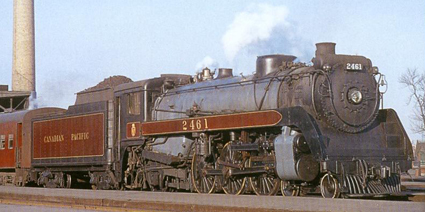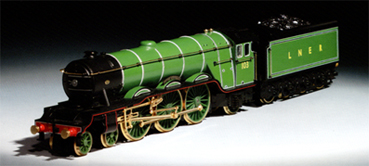Article
Transcontinental Steam - A Locomotive with Global Appeal
Author: John Faulkner
Date: 15 April 2010
Related Model: Transcontinental Pacific Locomotive
The Transcontinental Pacific Steam Locomotive was originally designed for the Canadian market and released in 1954 as part of the initial global “Transcontinental” range. The model was up-graded and improved many times over the years through the final production run in 1973; by which time it was being marketed as an Australian Pacific Steam locomotive!
The model appears to be based on a prototype Canadian Pacific type G3d built by Montreal Locomotive Works in 1926 and even carried an authentic running number “2335” for most of its long life. The 4-6-2 was not a common wheel arrangement for North America as it was a small engine by comparison to the requirements of North American operation. The “G” series engines used by Canadian Pacific however found plenty of work on short-haul passenger routes and branch-line operation until replaced by diesels in the early 1950’s.
Undoubtedly, Tri-ang used the 4-6-2 wheel arrangement to make use of existing componentary used on the British “Princess” models. In early years of production the model was available to the British market, although it was dropped in 1964. It made a brief re-appearance in the RS.102 “Express Freighter” train set in 1972.
Over the years many modifications were incorporated to improve the model, including; but not limited to, see through wheels, nickel tyred wheels, working head-light, smoke generator, and steam sound. Not all these features could be found at the same time on any given production run.
The white foot-plate stripe used and naming of the locomotive “Hiawatha” during the mid-sixties were both un-prototypical. However, these features certainly made an attractive model for marketing purposes and the target audience of young boys really didn’t object.
The most authentic model was the 1969 production run for Canada, where the model showed-up in proto-type Canadian Pacific livery, although the characteristic maroon band from the running plate and the tender insert were sadly both absent.
The final model production runs were made primarily for the Australian market starting in 1971. Although the model was still sold in Canada, contrary to the 1971 catalogue notation stating, “not exactly as illustrated” the Australian models did in fact replace the previous Canadian Pacific version. It was sold both as a solo model and in sets through the end of production and marketing for Canada in 1973, at which time it also disappeared from the Australian catalogue. By this time changes included re-numbering of the locomotive and tender to “1542” and the corresponding catalogue R. number was also changed, in accordance to R.1542N. The biggest change to the final production runs was the use of the non-corridor tender from the British “Flying Scotsman” model; minus the buffer head inserts. This change allowed the "Exhaust Steam" sound generator to be added to the model. Unfortuanately, the smoke generator inside the locomotive was no longer present.
Huge numbers were produced over the nearly twenty year production span. Today it is a popular model with collectors due to the fact it is a rather “unique” model in the Tri-ang range and the vast number of production variations made. It is relatively easy to come by on the used market and most examples are not exorbitantly priced, due to the vast numbers produced.
Writing these notes brings back fond memories of drooling over the 1967 Canadian catalogue image with “Hiawatha” at the head of a transcontinental Canadian freight train. Even today, I can still feel the imagery of a clanging bell and whistle hooting on a tranquil summer morning as only a boy of eight could do.




















